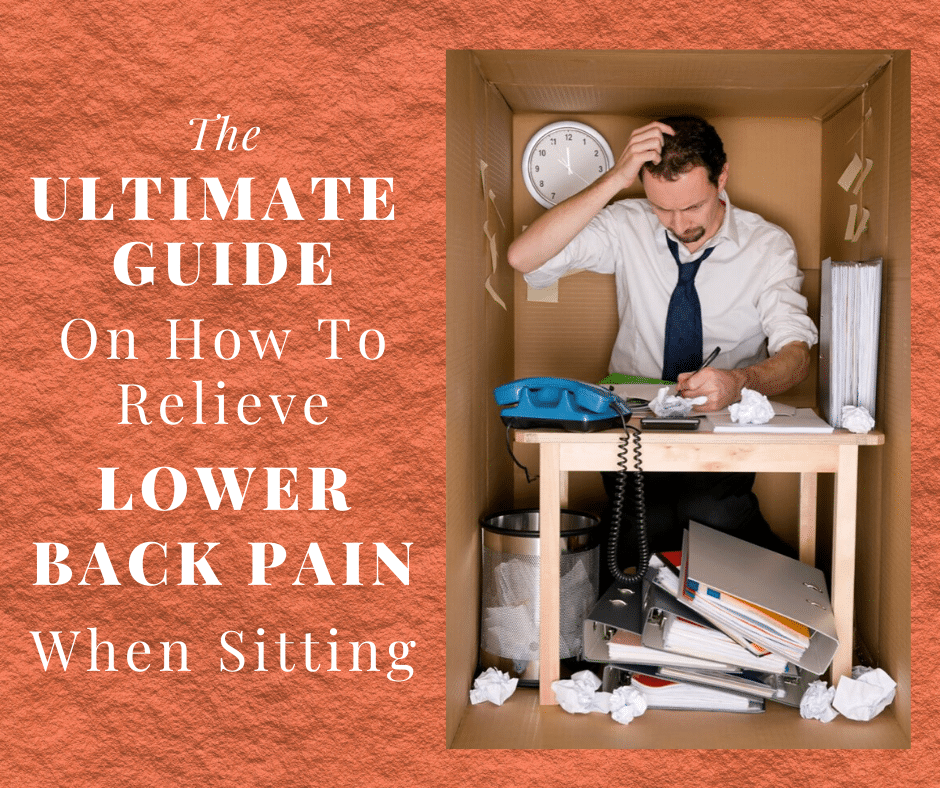
Do You Get Lower Back Pain When Sitting?
In This Post, You'll Learn How To Relieve Lower Back Pain When Sitting
In modern-day society, we spend a lot of time sitting.
- Sitting at work or school
- Sitting in the car to and from work or school
- Sitting watching TV or reading in our leisure time
But along with more sitting comes a number of other health consequences, including lower back pain when sitting TOO long.
This guide has been created in order to give you tips to prevent or help relieve lower back pain when sitting.
Use the links below to help navigate this page to make it easier to find the information you want.
Table Of Contents & Navigation Links
-
What causes lower back pain when sitting?
-
How can I relieve lower back pain when sitting?
-
How to relieve lower back pain when sitting in an office chair
-
How to relieve lower back pain when sitting in the car
-
How to relieve lower back pain when sitting in a recliner
-
How to relieve lower back pain when sitting on the couch
-
How to relieve lower back pain when getting up after sitting a long time
-
How to relieve lower back pain when standing up from sitting on a low couch or chair
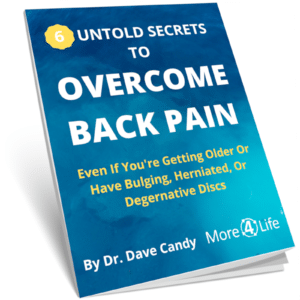
What Causes Lower Back Pain When Sitting?
It was assumed for years that pressure on the discs in the lower back was responsible for pain that people experienced when sitting.
This is largely due to a number of older studies in which the pressure inside the discs were measured with the spine (of cadavers) in various postures. Those studies found that disc pressures were substantially higher when sitting, than when standing or bending.
However, we now know that the presence of bulging, herniated, and degenerative discs on an MRI is a poor predictor of who DOES and DOES NOT have lower back pain.
There are many people that have bulging, herniated, and degenerative discs in their spine as well as arthritis that have NO PAIN AT ALL.
See the table from American Journal of Neuroradiology (Brinjikji, 2014) below showing how common these findings are on MRIs of people without back pain!
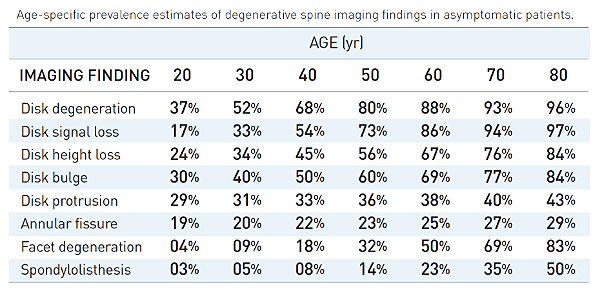
Furthermore, a newer study in The Journal of Electromyographic Kinesiololgy (Claus et al, 2008) show that intradiscal pressure is likely not responsible for lower back pain when sitting, and is not associated with faster disc degeneration or onset of lower back pain when standing.
So if not the discs...
What DOES cause lower back pain when sitting?
For MOST cases that I see clinically, lower back pain when sitting is more an effect of two things:
- Lack of blood flow and oxygen to the muscles (and discs) in the spine
- Sustained muscle tension when sitting
When you're sitting still for long periods of time, your body isn't moving much. Therefore, heart isn't pumping as hard or as fast. This means that your joints, muscles, and discs aren't getting as much blood flow as they should.
Blood flow brings vital nutrients to your body tissues, but even MORE importantly, it brings OXYGEN to it.
When your muscles (and other body tissues) try to work without oxygen, you get a build up of lactic acid and other chemicals that make your nerves more sensitive, which can cause a burning pain, or in some cases just a deep, achy pain.
This is the reason why some people also feel more stiff, sore, or achy when first getting out of bed in the morning after staying in one position all night.
When you add on top of that, that MOST people don't sit with their muscles relaxed, but rather held in a state of sustained tension - constantly under work.
When your muscles are working constantly without rest and without oxygen, this is a recipe for disaster - namely the development of lower back pain when sitting for too long.
So this begs the question:
How Can I Relieve Lower Back Pain When Sitting?
#1 Tip - Get Up From Sitting And Move More Often!
Sitting has become such a common activity in our society.
Long gone are the days of getting up early in the morning, hunting and gathering food all day, and then coming home and relaxing.
Instead we get up, sit at the table to eat breakfast, get in the car to drive to work, get to work and sit at a desk most of the day, get back in the car to drive back home, sit at the table to eat dinner, and then sit in front of the TV until we go to bed.
Then, do it all over again the next day.
The number of hours of sitting has been identified by the CDC as a major health risk on the same magnitude as smoking.
Lack of activity leads to all kinds of chronic health conditions like: obesity, diabetes, high blood pressure, heart disease, and chronic musculoskeletal pains such as lower back and neck pain.
So the #1 tip on how to relieve lower back pain when sitting is to get up and move around more often.
Ideally AT LEAST once every 60 minutes! But in the real world, that's not always possible. So, here are some other tips you can use to allow you to sit longer without having lower back pain...
How To Relieve Lower Back Pain When Sitting In An Office Chair
Much of what society has told us about "good posture" for your lower back when sitting is not based on fact but rather on traditions that have been passed down over the years without ever being questioned.
But did you know that much of what we know about "good posture" can actually can be quite bad for us?
You may hear your mother or grandmother in your head saying, "Sit up straight" or "Don't slouch".
Some people have gone as far as sitting on exercise balls or chairs without a back to it to try to activate their postural muscle and build a strong "core".
This information isn't based on medical knowledge, but rather what was considered prim and proper in Victorian Era society centuries ago.
Older research that showed that there is more pressure on the discs of cadaver spines gave some initial support to those mantras, but newer evidence is showing this may not be the case (see above).
I can tell you that I've seen hundreds, if not thousands, of people who have lower back pain when sitting, is actually caused by trying to have "good posture".
So, if you want to relieve lower back pain when sitting in an office chair use these tips along with the information in the video above.
Tips To Relieve Lower Back Pain When Sitting In An Office Chair
- Make sure you have an adjustable chair.
You should be able to adjust the height, recline, seat angle, and armrests. A headrest is also a nice bonus! If you're going to spend a lot of time sitting in a chair, investing in a good office chair (here's one example) will help you to relieve lower back pain when sitting at your desk. - Adjust the chair height so your feet are flat on the floor.
If they don't reach the floor, use a footrest or wedge like this one , so that your knees are at about the same height as your hips. For some people, even sitting with their knees slightly higher than their hips helps relieve lower back pain when sitting. This runs contrary to traditional advice... but if traditional advice hasn't helped your chronic back pain, maybe it's time to try something new! - Scoot all the way back in the chair so that your lower back is flat against the back rest
- RELAX! Don't "try" to sit up straight.
Allow your lower back to rest on the back rest. It may feel like you're slouching, and that's OK. (Don't believe it? Give it a try and if it doesn't help relieve your lower back pain when sitting, then go back to what you were doing before.)
Want More Tips You Can Use To Relieve Lower Back Pain?
Request our FREE Guide and get it sent instantly to your inbox!

How To Relieve Lower Back Pain When Sitting In The Car
Many people have lower back pain when sitting in the car on a long trip, especially if they're trying to make good time and not take frequent rest stops.
As noted above, it's ideal to get up and move every 60 minutes, but in reality, you're probably not going to want to stop that often on a long car trip. Try to shoot for stopping every 2-3 hours at most though.
Have trouble getting out of the car after driving a long time? Check out our post on "Getting In and Out of the Car Without Back, Hip, or Knee Pain"
In addition to making frequent rest stops, use these other tips to relieve lower back pain when sitting in the car!
- Adjust Your Seat So That It is Relatively Upright
Reclining slightly is okay, but the seat should be pretty close to a 90 degree angle. If you do recline the backrest, consider tilting the front of the seat up too (if your car can do that) , so that your spine to thigh angle stays pretty close to 90 degrees. - In Case You Didn't Catch It The First Time - RELAX
Allow your lower back to RELAX into the back rest and your head to RELAX on the head rest. Don't try to sit up tall with "good posture". - Don't Assume You Need The Lumbar Support
Taller people or people who have a very flat back, sometimes benefit from using a lumbar support. But for many people, especially if you have a large curve in your back or if you're shorter than about 5'6", keeping the lumbar support OFF actually allows them to flatten their spine out more. - Scoot Your Seat Up Close
This helps put little extra bend in your hips and helps further flatten the low back against the backrest.
Do also get neck & shoulder pain when driving in the car?
This video gives some good tips to relieve neck & shoulder pain when driving in the car, but the seat adjustments shown in the video also help relieve lower back pain when sitting in the car as well.
How To Relieve Lower Back Pain When Sitting In A Recliner
Sitting in a recliner is a great way to relieve lower back pain, but it's important that you do it correctly.
When you sit upright, gravity is pressing vertically through your spine creating compression on your joints and discs. Additionally, your muscles have to work harder to stabilize your spine.
However, when you recline, gravity presses your back into the backrest and makes it easier for you to relax your muscles.
The downside is that it also creates an extension in your spine as your hip to spine angle increases substantially greater than 90 degrees.
There's a simple fix to this though.
Instead of having your legs out straight on the recliner, bend your knees and place the bottom of your feet flat on the leg rest of the recliner.
Doing this will bend your hips back closer to 90 degrees. So now you've eliminated the effect of gravity pressing down through your spine AND you've also kept your trunk to thigh angle close to 90 degrees.
It's a win-win!
See the picture below for details of how to relieve back pain when sitting in a recliner.

How To Relieve Lower Back Pain When Sitting On The Couch
In order to relieve lower back pain when sitting on the couch, many of the same principles described in the sections above will apply:
- In general, you want your lower back flat, and your hips and knees bent around a 90 degree angle, for some people a little more and for others a little less. If your feet don't touch the floor when your back is flat against the backrest, prop your feet up on a stool or ottoman as shown in the picture.
- Alternatively, you can sit sideways on the couch with your lower back flat against the armrest and your feet out on the couch. Put a pillow under your knees to again help bend your hips closer to a 90 degree angle from your body
- Using arm rests or pillows will help take some stress off of your neck and upper back. The weight of your shoulder blades and arms hang from muscles attached to your neck, so supporting your arms will help take some stress off of your neck.
Learn more about how to sit on a couch or in a recliner without back pain or sciatica.


What Is The Best Way To Sit On A Couch With A Herniated Disc?
The best way to sit on a couch with a herniated disc in your lower back depends on when your symptoms bother you the most.
Younger, taller people with relatively little curve in their lower back tend to feel better with a pillow or lumbar roll in their lower back, especially if they have an acute herniated disc. If you've recently had an injury that cause a herniated disc in your back you might try using a lumbar roll like this one when sitting on a couch to maintain the curve in your lower back.
Older people with chronic back pain or who have had herniated discs for a long time tend to have the opposite problem.
As you age, discs that have been herniated in the past tend to lose height, and this decreases the space between your vertebrae.
In this case having too much arch in your back when sitting on a couch is NOT advisable as it creates further compression on the joints and nerves in the lower back.
So the best way to sit on the couch with herniated discs that are more chronic (or degenerative discs) is to sit all the way back against the backrest with your hips bent to 90 degrees or greater such as shown in the pictures above.
How To Relieve Lower Back Pain When Getting Up After Sitting For A Long Time
Getting in and out of a chair is a problem for a lot of people that have lower back pain.
Getting up from sitting can be particularly difficult after they've been sitting for awhile or if they're sitting on a soft or low surface.
For for the majority of us as we age, the task of standing up from a seated position, or getting up and down from a toilet can become more and more of a challenge.
Fortunately, learning how to move properly can make getting up from sitting easier.
Use the following steps to relieve lower back pain when standing up from sitting.
- Scoot to the front edge of the chair.
- Bend your knees to get your feet underneath of you.
- Lean forward to bring your center of gravity over your feet. Your bottom should almost naturally start to rise up as your head goes forward.
- Straighten your knees and allow your pelvis to roll under you, keeping your back slightly rounded.
- When you get all the way upright, don't lean backward. Even if it feels like you’re still bent over, you’re probably not...That's just the position that your body has gotten used to as the "normal".
Again, don't take my word for it... try it yourself and see if it helps you relieve your lower back pain when standing up from sitting. If it doesn't, go back to your old way of doing it.
Need Some Help Standing Up From Sitting On A Low Couch Or Chair? Raise It Up!
Need To Raise Some Furniture In Your Home?
Check out these furniture risers from Amazon.com
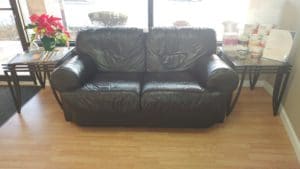
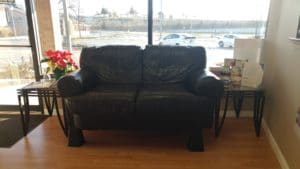
Want More Information on How To Relieve Lower Back Pain?
Download our FREE Guide!

Need Help For Lower Back Pain?
Choose one of the options below to get help from our back pain specialist...
Do you get sciatica or back pain when sitting?
If so, check our our posts "5 Tips To Avoid Sciatica Or Lower Back Pain When Driving"
and "How To Relieve Sciatica Or Lower Back Pain When Sitting On A Recliner Or Couch"

